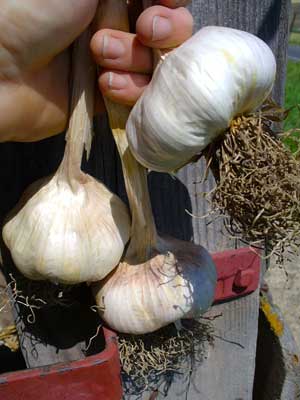Garlic and History
Garlic has been revered as an offering fit for the gods and despised as a substance suitable only to be fed to hogs. For over 5,000 years garlic has been used as food, medicine, an aphrodisiac, money, and magic potions.
Garlic warded off the evil eye, was hung over doors to protect medieval occupants from evil, gave strength and courage to Greek athletes and warriors, protected maidens and pregnant ladies from evil nymphs, and was rubbed on door frames to keep out blood thirsty vampires. Garlic clove pendants hung around the neck protected you from the sharp horns of a bull, warded off local witches, kept away the black plague, and even prevented others from passing you (or your horse) in a race.
Picture: Lorz Italian softneck garlic bulbs by red handle of barn door.
Garlic Payment and Religion:
This pungent herb is one of the oldest cultivated plants. It was worshiped by the Egyptians as a god and used as local currency. Clay garlic bulbs were placed in Egyptian tombs with the dearly departed. Archeologists are unsure whether the clay bulbs were intended as funds for the afterlife or as idols to appease the gods.
In addition, garlic was used to pay and feed workers and slaves on the great pyramids. The bulb was so popular with those who toiled on the pyramids that garlic shortages caused work stoppages. A garlic crop failure, due to the Nile flooding, caused one of the only two recorded Egyptian slave revolts. Garlic as currency is not necessarily an ancient idea; at Grey Duck Garlic we have found that some people are easily bribed with a basketful of the aromatic bulbs.
Despite its reputation for warding off evil and use as a medicinal herb, garlic was considered too coarse and common for the refined palates of the upper class. Only the rough lower classes could fill their bellies with garlic, it would upset the delicate constitutions of the rich and powerful. Egyptian priests worshiped garlic but actively avoided cooking and eating the fragrant cloves.
Other cultures also deemed garlic too pungent for religious institutions. Greeks wishing to enter the temple of Cybele had to pass a garlic breath test. Those who partook of garlic were not allowed entry. In ancient India, the upper crust denied themselves the pleasure of the pungent herb because of its strong smell and association with commoners. Likewise, knights reeking of garlic in King Alfonso de Castille court were cast out of polite society for a week.
In England, garlic breath was also deemed entirely unsuitable for refined young ladies and the gentlemen who wished to court them. Many Americans adopted the English attitude and didn’t embrace garlic until the 1940’s. Until then it was considered an ethnic ingredient and known by slang terms such as ‘Italian perfume’.
Garlic and Passion:
Garlic was both celebrated and condemned by the belief that it could inflame the passions. At times it was forbidden for Tibetan monks, widows, and adolescents to consume the stimulating herb. Chinese doctors prescribed garlic for men with ‘intimacy problems’. Grooms placed cloves of garlic in their buttonholes to ensure a happy honeymoon. Unfaithful Egyptian husbands chewed garlic on their way home from their mistresses to hide the scent of another woman. With all these garlic antidotes, is there any question why an Italian dinner is considered a romantic date?
Garlic inspired literary passion as well. The aromatic bulb is mentioned in ancient Egyptian, Greek, Indian and Chinese writings as well as the Bible, Talmud and Quran. Greek, Egyptian, Chinese, and European medicinal texts cite garlic as the cure for many ailments, including impotence, scorpion bites, heart disease, lack of energy, and the black plague.
Garlic Past and Future:
Garlic is believed to be a native of central Asia, South Asia or southwestern Siberia. There is some debate over the origin of this herb. It is one of the world’s oldest cultivated crops. Garlic lovers carried the pungent herb into Egypt, Pakistan, India and China. The crusaders brought back garlic to Europe. Later Spanish, French, and Portuguese settlers introduced garlic into the Americas.
The name garlic comes from garleac, an old Anglo-Saxon word meaning "spear leek." Garlic is believed to be descended from Allium longicuspis, a wild strain of Asian garlic but its origins are still in question. It is from the lily (Liliaceae) family and related to onions, leeks, chives, and shallots.
Garlic consumption in the United States has tripled since the 1990’s, with more people discovering the delightful properties of this bulb. Worldwide there are over 2.5 million acres in garlic cultivation! That's a lot of garlic!
